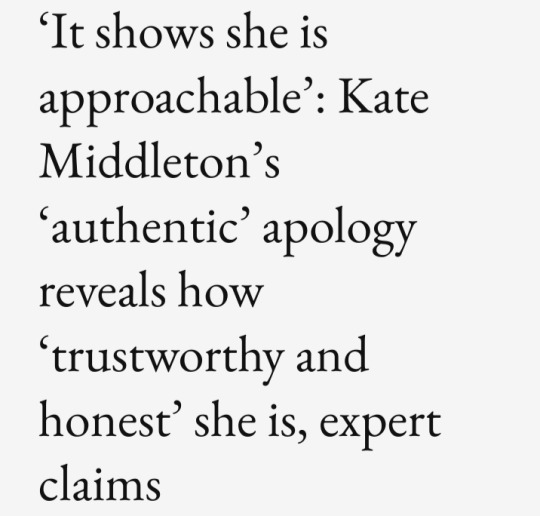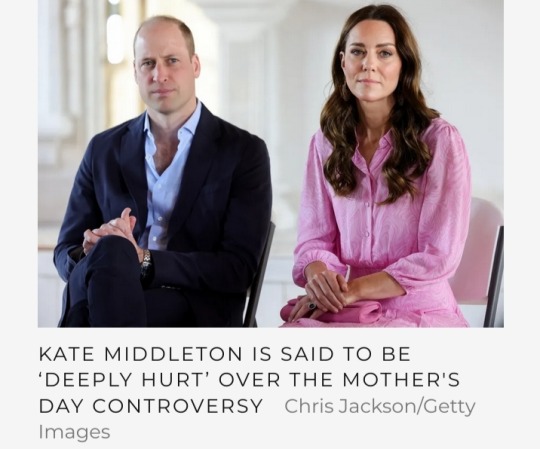#Thomas Attwood
Text
Every single thing I learn about Thomas Attwood Digges is more insane than the last. what do you mean there was an evil american founding father who moved to Belfast to steal things
60 notes
·
View notes
Text



The Princess of Wales’ ‘authentic’ apology shows how ‘trustworthy and honest’ she and Prince William are, a PR expert has claimed.
Catherine Middleton issued a public statement after the now infamous Photoshopped image released for Mother’s Day caused a frenzy online.
It marked the first time the Princess had been seen officially since her surgery and was supposed to quell social media rumours, which had become a frenzy in recent days.
However, after the picture was released on Sunday, eagle-eyed members of the public were quick to point out a number of ‘errors’ in the image which appeared to have been digitally manipulated.
The Palace came under immense pressure over the picture after it was withdrawn by Reuters, AP, Getty, and AFP, before the Princess released a statement to reveal she, in fact, had edited it.
In a post, Catherine Middleton wrote:

Now, a PR expert has said she believes the apology should put the barrage of social media rumours and frenzy of tabloid speculation to rest.
Sophie Attwood, PR Expert and Author of Beautiful PR: Finding Your Brand’s Heartbeat For Authenticity In Communication, told Tatler it was ‘not surprising’ that the image had caused such a ‘controversy’ — but that Catheine's statement has been key to restoring confidence in the Princess.
She said:
"Trust and open communication are the key to the success of any brand, especially in an age in which social media grants us greater access to these people than ever before.
The Royal Family have done the right thing in addressing the situation with the honesty and openness that the public have come to know and expect."
Attwood went on to detail how Catherine’s apology showed she was ‘approachable and human’, saying:
"The Princess of Wales’ recent apology is written from herself and does, for me, appear authentic. Signing off with simply a ‘C’ is also a good move, she’s suddenly approachable, human and has simply made a mistake.
I also really like the fact that this has been designed to appear as a really short apology, leveraging the shorter character count on Twitter and reducing the formality of the situation — acknowledging the stories but making the situation appear like it's simply not a big deal."
Attwood went on to say she expects the public to forgive the Princess for the furore, and said they know Catherine and William to be ‘open and honest.’
She added:
"The steps that [the royals] have taken in order to address the confusion and reinforce the idea that they are trustworthy, honest and open will likely support this."

After the admission, the Princess was pictured as she joined Prince William on the drive out of Windsor ahead of the Commonwealth Day Service.
She didn't join the royal family at the event however, instead attending a ‘private appointment.’
Reports suggested the Princess has been left hurt by the scandal, which has been caused.
A palace insider told The Telegraph that Catherine had just tried to make the picture the ‘best it could be.’
Meanwhile, according to the Mirror, a friend of the Princess said she was ‘deeply upset’ over the storm caused by what was supposed to be an ‘innocent family photograph.’
As to exactly when Catherine will return to duty, that is still yet to be seen. But, amidst the controversy, Prince William has been continuing with public engagements.
He led the royal family at the Commonwealth Day Service on March 11, before attending the private funeral for Thomas Kingston on March 12.
On March 14, he’s due to visit WEST, the new OnSide Youth Zone in Hammersmith and Fulham, before marking the 25th anniversary of the Diana Award by attending the Legacy Awards.

#Prince William#Prince of Wales#Princess of Wales#Catherine Princess of Wales#Catherine Middleton#Kate Middleton#British Royal Family
23 notes
·
View notes
Text






Detective Jacqueline Chadwick and her partner Thomas Attwood
#digital art#artists on tumblr#artwork#art#oc#oc art#my ocs#original character#my art#ocs#SwingRiver
4 notes
·
View notes
Photo

George Augustus Polgreen Bridgetower (October 11, 1778 – February 29, 1860) was a British musician, of African descent. He was a virtuoso violinist who lived in England for much of his life. He was born in Biała Podlaska, Poland, where his father worked for Prince Hieronim Wincenty Radziwiłł. He was baptized Hieronimo Hyppolito de Augusto. His father, John Frederick Bridgetower, claimed to be an African prince. His mother, Maria Anna Ursula Schmidt, was from Swabia. He moved to London at an early age and was performing as a violin soloist at the Drury Lane Theatre by the age of 10. He exhibited considerable talent while still a child and gave successful violin concerts in Paris, London, Bath, and Bristol. The British Prince Regent took an interest in him and oversaw his musical education. At the Prince's direction, he studied under François-Hippolyte Barthélémon, with Croatian-Italian composer Giovanni Giornovichi, and with Thomas Attwood, organist at St Paul's Cathedral and professor at the Royal Academy of Music. He performed in around 50 concerts in London theatres, including Covent Garden, Drury Lane, and the Haymarket Theatre and he was employed by the Prince to perform in his orchestra in Brighton and London. He performed to great acclaim at the Abbaye de Panthemont in Paris. He was given leave to visit his mother and brother, Friedrich Joseph Bridgetower, a cellist, in Dresden, and he gave concerts there as well. Beethoven was impressed with his talent and dedicated his Violin Sonata No. 9 in A minor (Op.47) to him, with the jocular dedication "Sonata mulattica composta per il mulatto Brischdauer, gran pazzo e compositore mulattico". Though Beethoven had completed the composition, the piece received its first public performance at a concert in the Augarten, with Beethoven on the pianoforte and he on violin. He had to read the violin part of the second movement from Beethoven's copy, over his shoulder. He made a slight amendment to his part, which Beethoven gratefully accepted, jumping up to say "Noch einmal, mein lieber Bursch!". Beethoven presented him with his tuning fork. #africanhistory365 #africanexcellence https://www.instagram.com/p/Cjkhr5sLW0D/?igshid=NGJjMDIxMWI=
1 note
·
View note
Link
Attwood Unleashed is a weekly thought-provoking multi-hour broadcast with an eclectic range of guests. Order of guests: Lord Mountbatten: Andrew Lownie Julian Assange: Thomas Schulze IPP Sentences and Julian Assange’s Case: Pepsi Watson Ian Watkins & the Dark Net: Ron Swanson
0 notes
Text
Music Notes for Lent IV
Music Notes for Lent IV
The opening hymn at this week’s service of Holy Communion will be Peter Abelard‘s (1079-1142) hymn ‘O what their joy and their glory must be’, translated by John Mason Neale (1818-1866). The Latin text, O quanta qualia sunt illa sabbata was written by Abelard for the hymnal used by the convent of the Paraclete near Paris founded by Heloise, Hymnarus Paraclitensis. See Analecta Hymnica 48: 163. Ne…
View On WordPress
0 notes
Text
There's just something about the entire concept of Thomas Attwood Digges as a person that's comical to me
7 notes
·
View notes
Text
Music for September 2, 2012
I think it’s a little funny that the music at church this Labor Day Weekend (a uniquely American holiday) comes from the body of British Church Music spanning two centuries. In reading the Gospel for this week, I was reminded that while Jesus was an observant Jew, he was often at odds with the Pharisees, who were strict followers of the law. Jesus had to point out to them that they were following the letter of the Law while ignoring its spirit, thus going against the will of God. With all this talk of the Law, the anthem by the early19th century English organist, Thomas Attwood, Teach Me, O Lord came to mind.
Teach me, O Lord, the way of thy statutes, and I will keep it unto the end (from Psalm 119
It would be a good choice for the scripture, but also for a choir that might have smaller numbers due to the four-day weekend.
Thomas Attwood (1765 – 1838) was an English composer and organist who began his musical career at age 9 as a chorister in the Chapel Royal. When he was 18 he was sent to study abroad at the expense of the Prince of Wales, who had been favorably impressed by his skill at the harpsichord. After two years in Naples, Attwood proceeded to Vienna, where he became a favorite pupil of Mozart.
On his return to London in 1787 he held for a short time an appointment as one of the chamber musicians to the Prince of Wales.
In 1796 he was chosen organist of St Paul's Cathedral, and later composer to the Chapel Royal, musical instructor to the Duchess of York and the Princess of Wales, and professor at the Royal Academy of Music. He was buried in St. Paul’s, close to the organ.
Once I was in the British frame of mind, other music made itself available to me from England. The opening voluntary is by Sir John Stainer (1840–1901) an English composer and organist whose music, though not generally much performed today (with the exception of The Crucifixion, still heard at Passiontide in many Protestant churches of the former British Empire), was very popular during his lifetime. His work as choir trainer and organist set standards for Anglican church music which are still influential. He was also active as an academic, becoming professor of music at Oxford. According to Peter Charlton's biography, Sir Arthur Sullivan's tribute to Stainer was blunt and memorable: "He is a genius".
The closing voluntary is a modern adaptation of a voluntary for organ by the Englishman William Walond by the English-born organist E. Power Biggs. Unlike John Stainer or Thomas Attwood, Walond was not one of the great organists of his day, serving as a music copyist and assistant organist at Christ Church Cathedral, Oxford. His contribution to organ music is a collections of voluntaries, or freely composed keyboard pieces much like the prelude and fugues of the 18th century German organists. In this modern adaptation, Biggs creates a pedal part, as the pipe organ of the 1700s in England had no pedals.
Anthem
Teach Me, O Lord, the Way of thy Statutes - Thomas Attwood (1765-1838)
Voluntaries
Adagio – John Stainer (1840-1901)
Let All Mortal Flesh Keep Silence – arr. Rudy Davenport
Toccata in G Major – William Walond (1725 - 1770), arr. E. Power Biggs
Hymns
Lift up your heads, ye mighty gates (TRURO)
O Master, let me walk with thee (MARYTON)
Lord, be glorified (LORD, BE GLORIFIED)
Give thanks with a grateful heart (GIVE THANKS)
Rejoice, ye pure in heart (MARION)
Psalm 15 – Tone VI
0 notes
Text
Kind of obsessed with the fact that after turning England into something one only speaks of in the past tense Wolfe Tone's second life ambition, to the point of demanding of the prime minister and multiple cabinet members the manpower to accomplish it, was becoming some kind of Robespierre type figure in a unified South America after convincing everyone there to violently seize control from the occupying governments, an idea which was put in his head by Thomas Attwood Digges, a man from Maryland who was in Belfast seemingly to just cause problems on purpose, and who was so despised in America in his time for conning most of the founding fathers that people there had to write & publish theses on why he wasn't actually that bad so that people would stop wishing him bodily harm. SO much to unpack there what on earth
7 notes
·
View notes
Text
A TALE OF ONE CITY
A TALE OF ONE CITY
"The present century has seen the rise and development of many towns in various parts of the country, and among them Birmingham is entitled to take a front place. If Thomas Attwood or George Frederick Muntz could now revisit the town they once represented in Parliament they would probably stare with amazement at the changes that have taken place in Birmingham, and would require a guide to show them their way about the town--now a city--they once knew so well. The material history of Birmingham was for a series of years a story of steady progress and prosperity, but of late years the city has in a political, social, and municipal sense advanced by leaps and bounds. It is no longer Brummagem or the Hardware Village, it is now recognised as the centre of activity and influence in Mid-England; it is the Mecca of surrounding populous districts, that attracts an increasing number of pilgrims who love life, pleasure, and shopping. "
A TALE OF ONE CITY
#frederick muntz#thomas attwood#leaps and bounds#material history#brummagem#george frederick#steady progress#amazement#pilgrims#mecca#prosperity#parliament#pleasure
0 notes
Text
Idk if he's even on the bracket but in MY opinion. Thomas Attwood Digges deserves to win that worst founding father contest
2 notes
·
View notes